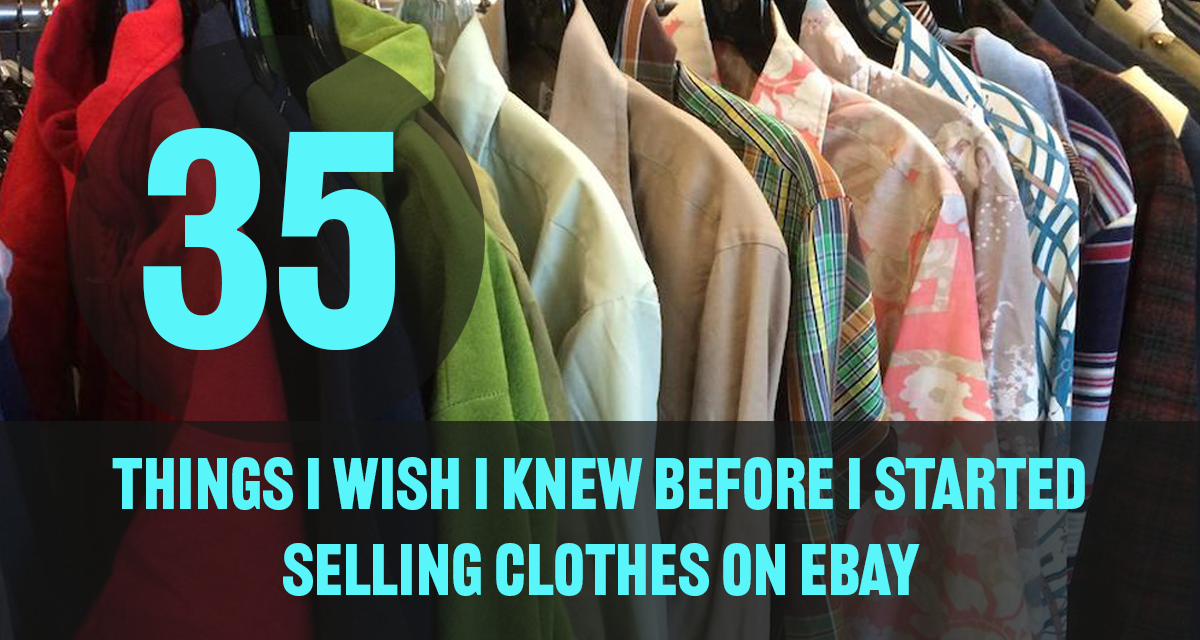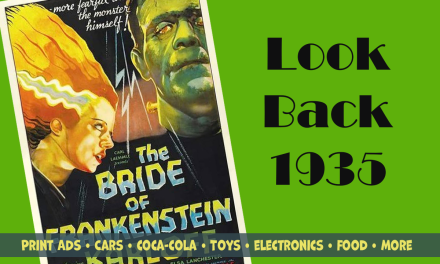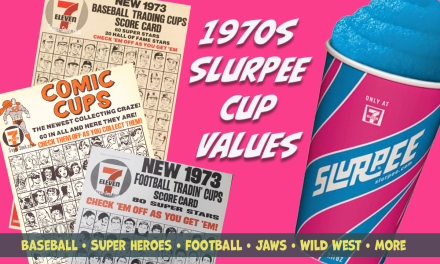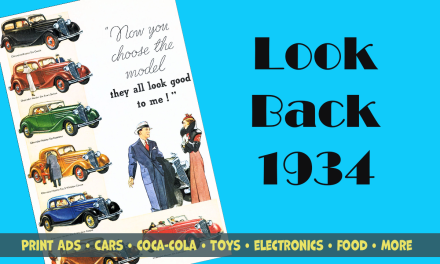35 Things I Learned Selling Clothes on eBay
Thinking of selling clothes online to make some extra cash?
I started selling my own clothes and thrift store purchases in 2021 and I have learned a lot. While I have found $8 shirts that I have sold for over $100, I have also found great $8 button-up shirts that never sold and I eventually donated back to the thrift store. Over the course of my first two years I have sold hundreds of pieces of used clothing I purchased at thrift stores, estate sales and yard sales.
I have learned a lot and wish I had found a good resource about thrifting, reselling and shipping when I started. However a lot of the blogs I read offered only a few tips and just kept plugging they earned tons of money selling on eBay.
The truth is it takes time, effort, patience and in some cases a little luck to create and run an eBay store selling vintage and new clothing online.
You’ll need less luck though once you read my 35 Things I Wish I Knew Before I Started Selling Clothes on eBay, because you’ll know a variety of tips, tricks, best practices and the realities associated with re-selling clothes online.
Thrifting Basics
1. Old Does Not Always Mean Valuable
It is always exciting when you are going through a rack and find a polyester, Hawaiian or disco shirt from the 1960s or 70s. While some of these shirts sell for $40, $50 and over $60, many of the older shirts (that are now 40 – 50 years old) have condition issues or are rather basic sell for $14-25.
To improve your chances of a successful purchase, look for bold and unique designs, fabric textures, and brands like Sears Kings Road, JCPenney, and Campus.
2. Rare Clothing Brands Do Not Always Mean Valuable
There are thousands of clothing labels. Some are from small boutiques, department store private labels, brands that were trends, and others are name brands that have been around for decades like ralph Lauren. Plus sometimes garments have no labels because they were home sewn.
Finding a little known brand shirt or dress doesn’t mean you’ve hit the lottery, it means that you need to research the brand, see if there are other listings and see if the brand sells. Unless a brand had a pop culture moment, was iconic in its day, or was associated with an event or trend (i.e. – 70s disco shirts) that people remember fondly, there is often little demand for a rare brands as hundreds come and go every decade.
3. Know & Understand the Clothing Resale term “Vintage”
Vintage has several meanings including “Old” and “Dating from the past.” While the term can be used to denote any piece of clothing, the term “Vintage Clothing” in the industry means the garment is at least 20 or more years old.
Thrift Store Shopping Tips
4. Always Check for Rips, Holes & Tears
You found a vintage Polo Ralph Lauren 1990s shirt for $9 and it sells for $70 on eBay. You are so excited you add it to your cart and move on to the next rack. Once your home you review your thrift store haul and start getting ready to list your items when you notice a rip in the neck underneath the collar, in the hem, or under the arm pit and your heart sinks.
In my first few months, I purchased several shirts with these flaws and soon afterwards started doing a final pre-purchase check on every item before I got in line to purchase the item.
5. Always Check the Buttons and Zipper
It sounds silly, but always check for all the buttons and test the zippers. People are always trying on thrift store shirts and blouses, so it is not unusual to find unbuttoned shirts on the racks and this makes it easy not to notice something is missing. I have purchased shirts with missing button down collar buttons, front of the shirt buttons and the button on the sleeve cuff gone. So always double check.
The same thing goes for zippers. Always unzip and the zip a jacket, dress, shirt or jeans to make sure it works. A broken or stingy zipper can lead to money wasted or a future bad review if you do sell it.
6. Do a Final QC Check Prior to Purchase
Once you have selected all of the clothes you would like to purchase, find a space to review all of the items one at a time. This Quality Control check should be to look over the thrift shirt, dress or garment and check for flaws. Check for holes, missing buttons, stains, rips and decide which garments are being purchased and which ones are going back on the racks. I find that I eliminate about 20-30% of the items that I wanted to purchase during my QC check.
7. Avoid Tagless Shirts
Tagless t-shirts were introduced in 2002 by Hanes and started to become gain traction among major brands in the late 2000s. Tagless shirts save manufacturers money and most consumers find the shirts more comfortable, but tagless shirts are also a dead giveaway that the garment is new and not vintage. The one major downside to tagless shirts is that the information about the brand, size and care slowly washes away!
Today you’ll find t-shirts, polos, athletic wear and even some button up shirts have gone tagless. As a general rule pass on tagless garments, unless you do the research and know that you can sell the item for a good profit.
8. Know Your Thrift Store Deal Days and / or Color Promo Schedule
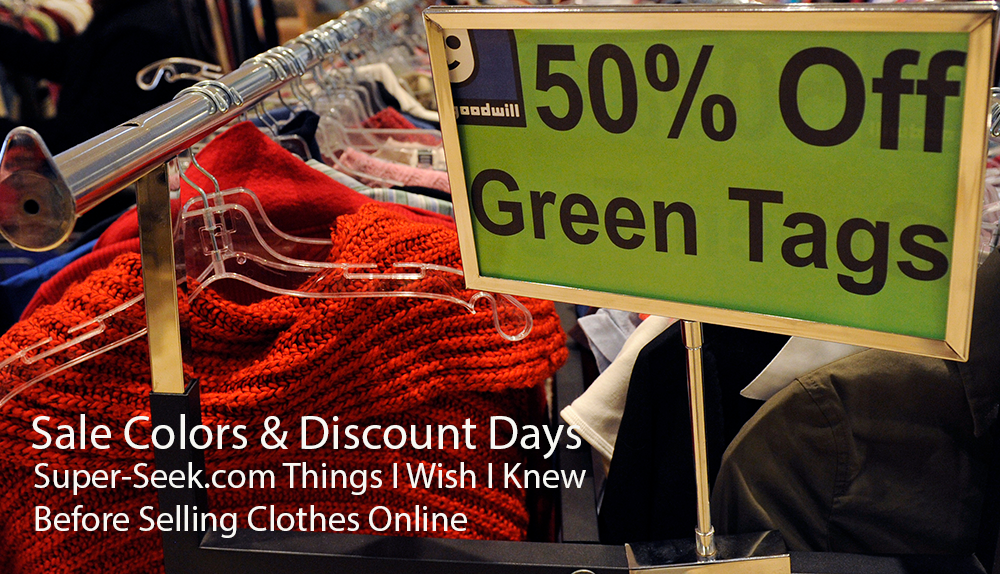 Thrift stores receive new donations are day and new to keep there inventory fresh to keep customers coming back. In order to manage inventory clothes are tagged with a color or number that identifies the week the item was put out for sale. In order to motivate customer to purchase aging inventory and make second-hand shopping exciting thrift stores may have a weekly % off day, a seniors % off day, or a day when the 50% off a select color switches. Also some stores to store wide 40-50% off days that tie in with major holidays and back to school events.
Thrift stores receive new donations are day and new to keep there inventory fresh to keep customers coming back. In order to manage inventory clothes are tagged with a color or number that identifies the week the item was put out for sale. In order to motivate customer to purchase aging inventory and make second-hand shopping exciting thrift stores may have a weekly % off day, a seniors % off day, or a day when the 50% off a select color switches. Also some stores to store wide 40-50% off days that tie in with major holidays and back to school events.
If you are reselling clothing online knowing when and how to gets these discounts can save you a lot of money and allow you to make more money.
9. No Returns! – Most Thrift Stores Have a No Return Policy
Salvation Army, Goodwill and many of the thrift stores I have visited DO NOT ACCEPT CLOTHING RETURNS, so once you buy it; it is yours. Just be sure you want the item before you head to the check out line.
Those thrift stores that do have a return policy, often have very specific return policies rules. We have one where you can return items within 14 days with tags on, but you must use the return credit on the same day the clothes are returned. In this case I always wait at least a week or more to return the items so that there is new inventory in the store.
10. Some Thrift Stores are Better than Others
Each thrift / second hand store is different. In Orlando, the price of a men’s pre-owned long sleeve button up shirt can $6 at the Salvation Army, while at Goodwill they run $9-$13. Also some of the smaller neighborhood thrift stores can be a direct representation of the community where it is located, so thrifts in wealthy neighborhoods may have more branded and luxury goods, while stores in older neighborhoods created before or during the 1960s may be more likely to score vintage clothing more often.
If you are going to do reselling, I suggest you visit a variety of thrift stores. Compare pricing, the type of merchandise you find and then continue to shop where you find the best value and clothing that sells.
11. Use Google Image Search to Identify Unique Shirts / Jerseys
Have a t-shirt, shirt, dress, blouse, or sports jersey and need help trying to identify it? Try Google image search where you can take a photo from your cell phone and Google will search it’s images to try to identify your garment.
This is not very useful with plaid and solid colored shirts, but it can help identify t-shirts, sports jerseys, and garments with unique patterns and iconic looks. I would say I find a match 40-50% of the time. It helps quickly identify the shirt or garment and if it is on sale on eBay, Poshmark or even Amazon it will often show the price so you can get an idea of value.
12. Use the eBay App to View Supply, Pricing and What Items Sold For
The eBay app is a great resource to look up items quickly and see what is available and what things sell for. This gives you a quick indication of supply and demand and whether you want to purchase an item.
Here is how I use the eBay app. I find a shirt and then I type in the brand, type of shirt (polo, t-shirt, button down), long or short sleeve, and a descriptive terms (plaid, stripe, image, color) and hit search. I review how many listings 0, 5, 10, 50 and so on and look to see if I can spot the exact shirt I have just to get an idea of what it might be listed at.
Once I have scanned the listings and have an idea at what items are priced at, then I use the eBay filter and click on Sold listing to see if any of this type of item has sold. This tells me what people are willing to pay for this item. While the listings may show for sale at $40, the sold price might be $15, $25 or $40. A selling price under $20 is normally a do not buy signal for me, but if I can make $20 or 30 on a shirt I am willing to consider making the purchase.
You may not always find an exact match for your item, but it will often give you an idea if a brand sells well and at a good price. You want brands that sell, rather ones that do not and this gives you the tools to make better decisions.
13. Made in USA, Made in Italy and Made in China
When you are thrifting you want to pay attention to Made in USA clothes as they often mean older and / or vintage shirts as they do not make many clothes in the US anymore. Also shirts, dresses and garments that have tags noting Made in Italy are often high quality and worth researching and evaluating. (If you get lucky you might find a Gucci, Versace or Armani garment.)
US clothing brands started shifting clothing manufacturing to China in the mid-1990s. So when you see Made in China on the label, it means that the clothing is newer and if it is not a brand name you recognize it might be best to pass. One example I can share is Hawaiian shirts; if it is Made in Hawaii always investigate as some brand’s of Hawaiian shirts can sell for $30-$100, however Hawaiian shirts that are Made in China are a dime a dozen and they tend to sell for $10-$20.
14. You will Purchase a Counterfeit Item
Often you can spot a fake Polo Ralph Lauren shirts, because RL labels are very consistent, so when something is off you notice. However I have purchased a fake Hugo Boss, Burberry and a foreign sports jersey even when I was looking for fakes!
So what do you do if you purchase a fake shirt, dress and pair of jeans? First – Do not sell it on it on eBay as it against eBay policy to knowingly sell a counterfeit item. Plus if you do sell it, it harms your seller reputation. Second – Since it is a garment that can be used, you can donate it back to the thrift store or destroy it. (I donate them back to the thrift store.)
15. Some Clothing Brands include Manufacture Dates
Nothing is more helpful in determining when a garment was manufactured than finding a production date on the tags. Levi’s has used them for decades. Tommy Hilfiger started including them in the 2000s, and GAP, American Eagle, Abercrombie & Fitch and other brands started including them over the last 10-15 years. Some tags are coded, but others are easy to read.
The reason for adding these tags vary, but many mall based stores started to include the tags so the employees would quickly know the age of items being returned. No longer could someone walk in and say I just bought this shirt and I want to return it, when the sales associate can easily point out the item was from 2 or 3 years ago.
16. You’ll Need to Learn to Remove Stains
Nothing ruins a great thrift store purchase more than getting ready to take photos for your listing, turning on your photo lights and finding unexpected stains on a shirt. Thanks to poor store lighting many stains can go unnoticed, until you are ready to list it.
You should be able to get most of the stains out of the garments with Shout or Oxi-Clean. However, there are times I’ve had to get a brush out and use nail polish remover, rubbing alcohol and / or dish soap on the stain and sometimes it still does not come out. In that case you can sell the clothing as is or donate it back to the thrift shop.
17. You’ll Need a Lint Roller
You are going to purchase clothing that attracts or has lint and / or hairs on them. Black fabrics and some sweatshirts tend to be lint magnets, so a lint roller is needed to remove those pesky hairs and lint.
18. Knowing How to Sew is a Plus
If you accidently do purchase a shirt, dress, or jacket with a tear, seam separation or loose hem, knowing how to sew is extremely handy as you can repair the garment and list it.
19. Bad Purchases can Be Donated
Sometimes you purchase a garment with high expectations, list it and nobody wants it even after you lower the price several times. Well the good news is that you can always donate it back to a thrift store, move on and take the tax credit.
20. Little Known Brands often Sell for Less
Some brands last decades, while others may last a few years. However lesser known brands often sell for less because fewer people seek those brands (less demand). Are there exceptions? Yes. Brands with a unique notoriety or fad induced (men’s disco shirts) can sometimes bring in more, but in general if you’ve never heard of it or don’t remember it almost no one else does either.
21. Mall Based Store Brands Don’t Bring Big Profits
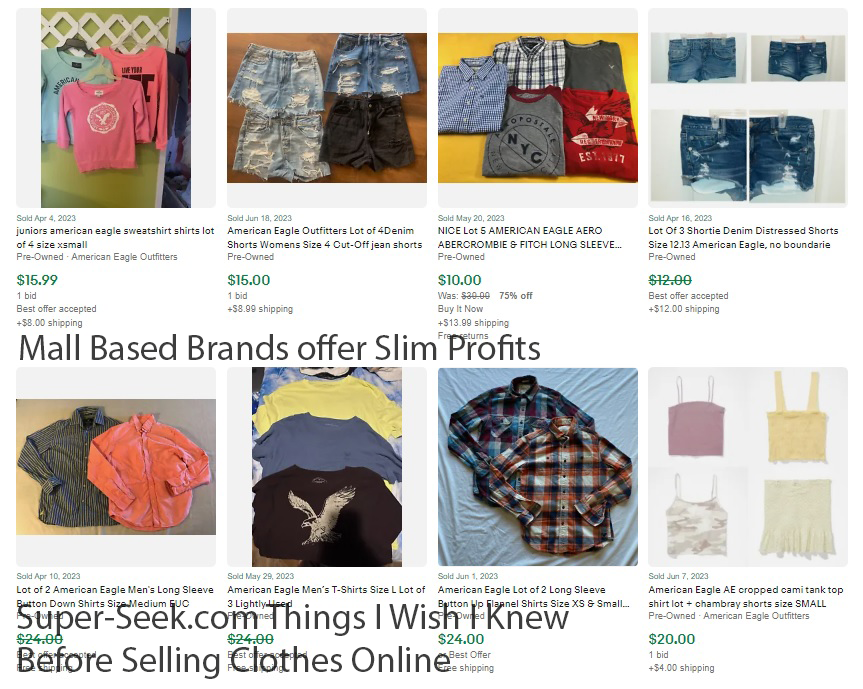
Pre-owned clothing from American Eagle, Zara, Forever 21, Hollister, Abercrombie, GAP, Old Navy and other stores found in the mall rarely bring big profits. I find that most of these t-shirts, button ups, and dresses tend to sell in the $5-20 range. I took a screenshot of recent eBay sales and someone sold 5 shirts with shipping for $24! That’s less than $5 a shirt and cheaper than some thrift stores!
While there are exceptions to the rules, like a shirt style that was in a popular movie or a brand that partners with a celebrity or designer, in most cases pass on teen retailer merchandise.
Related Video
Resale Clothing Inventory & Management
22. You Need Space to Store Your Inventory
You had an amazing thrift store haul and have two to three bags of clothing to sell! Great job, but kind in mind that you have to store that clothing until it sells which can be a week, a month or even a year. Yes, you may not sell an item for over a year.
Know that you need to manage your inventory, keep it organized, and properly store it. I recommend banker boxes and/or storage tubs. Then you can mark the outside of the box with a number or label that identifies so you know where everything is when it sells.
I put t-shirts, jerseys, short sleeves, long sleeves and outwear in different boxes and then have a specific box for Polo Ralph Lauren one of my favorite brands for selling online.
23. Track Your Inventory
Whether you are reselling clothing as a hobby or a business you need to track your inventory and know whether you are making money, breaking even, or losing money.
![]() I created a spreadsheet where I track every item, date of purchase, cost, where I bought it and where it is stored prior to the sale. Once the item sells, I move it to the sold section (See above) and note shipping costs, profitability and date sold. This is extremely valuable for tax season. Over time I have found this has help me evaluate my purchases and make better buys.
I created a spreadsheet where I track every item, date of purchase, cost, where I bought it and where it is stored prior to the sale. Once the item sells, I move it to the sold section (See above) and note shipping costs, profitability and date sold. This is extremely valuable for tax season. Over time I have found this has help me evaluate my purchases and make better buys.
24. Set a Dollar or Quantity Limit for Your Inventory
I found it was easy to go and keep buying clothes to resell at thrift stores. There were great opportunities every week and I spent time tracking them down and spent $200, $300 and even $400 in one month as I worked to find items I could flip. However my inventory ballooned as I was buying 10-20 garments a week and selling 5-10 shirts. The result was I soon had over $1,100 in clothing inventory! I guess I was thinking was the more I own the more I could make.
I knew things had to change, so I paused my thrifting and began to work down my inventory based on a dollar amount. Today, I have a set my investment inventory at $800 and sell additional garments on consignment.
I recommend that you set either a dollar limit on your reselling inventory ($200, $500, $1,000) or set a quantity limit (20, 50, or 100) when getting started as it helps to test whether you enjoy reselling clothing and it helps you to try to pick out the best of the best items.
Plus set these limits allow you to know how much you have available to spend or how many new items you can purchase the next time you hit your favorite thrift store.
Pricing Clothing on eBay and Profits
25. eBay Takes 10-15% of the Total Sale (including Shipping)
You expect an online sites like eBay, Poshmark, Etsy and others to take a % of the sale, but know before you sell. eBay and others often take a % of the product sold + shipping. So if you sell a shirt for $10 and $5 shipping and they take 15% eBay takes $1.50 for the shirt and another .75 for the shirt. (So eBay earns a total of $2.25). This caught me off guard at first since shipping is a pass through fee and you earn nothing from it. Today, I tend to bump up my shipping costs to cover eBay’s cut.
26. Start with Buy It Now
Auctions are exciting and profitable, if there is high demand for your item. However online auctions come with a risk. That risk is you don’t know whether an item will sell for $2, $5 or $50 and clothing is tricky because brand, size and color / design all come into play when making a sale. While auctions are great for clearing out inventory, in most cases clothing auctions underperform and can result in selling at a loss.
eBay’s Buy It Now feature allows you to set a fixed price to sell your item which allows you to control the profitability. I prefer Buy It Now because I can price and item at where I know I can make a good profit. In addition, you can see the interest in your listing by seeing how many watchers keep tabs on your listing.
27. My 4 Times the Purchase Price and $20 Rule
When I started thrifting I didn’t have a buy formula or rules, I thought just selling something for more than you bought it was enough. After a month or two, I quickly realized that the time and effort to earn $5 – $10 on a shirt so I create my thrift shopping rules to help insure profitability.
So I want to be able to sell $5 items for at least $20 and $10 items for around $40. This rule, in addition to doing in store research, helps me make better decisions and buy items with better profits. These rules are foolproof but they stop me from over buying, and my profits per shirt has increased.
There is an exception to my rule! My $20 rule; which states if I believe I can clear $20 on this item consider purchasing it. This rule came to be on days when I would spend time thrifting and find nothing or just 1 or 2 items that hit my 4 times the purchase price rule. I wanted to get something out of the time I invested second hand shopping and knowing that I could make $20 on a shirt would at least cover gas and my time, so I created my $20 rule.
28. Pricing your eBay Clothing Listing
This is such a tricky subject because there are so many nuances to every listing, but I am going to try to give you a quick guide using the Brooks Brothers Blue Oxford Cloth Shirt which I sold within a week as an example. (FYI- Few things sell this quick, but this did.)
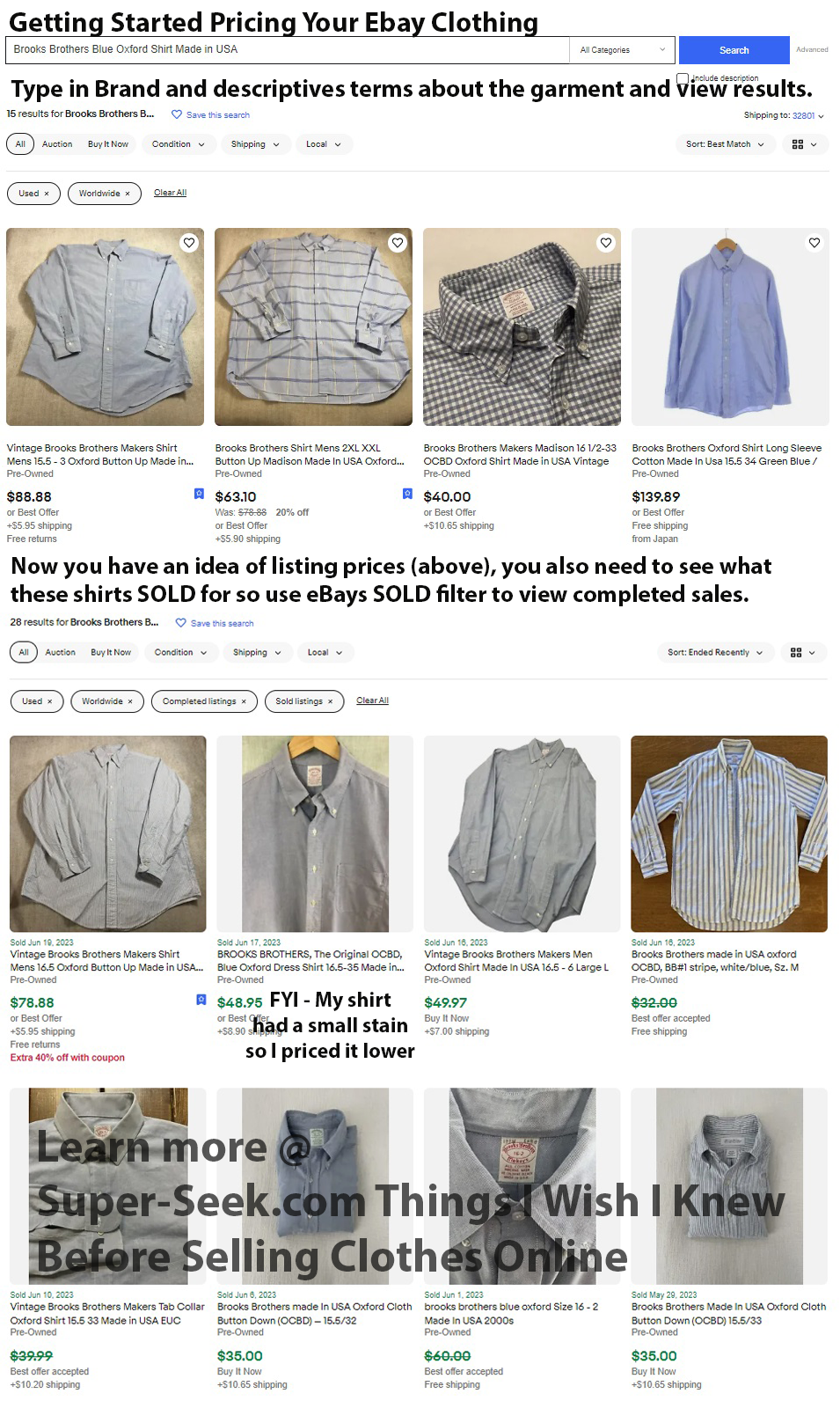
Please know that condition, age of the garment, and whether Made in USA played a part in determining to price my shirt at $48.95. Because of these variances it is not a true apples to apples comparison.
Here are the Pricing Steps I Took.
a. I did a search on Used Brooks Bros. shirts and saw 16 results. Listed prices ranged from upper $30s to over $100. FYI – You can list for $1,000 but it doesn’t mean anything if you can’t sell it.
b. Then using eBay’s filters I selected “Sold” and got 28 results with Sold prices ranging from $30-70. (I think the $78 one was 40% off). I reviewed the Sold listings and found 2 shirts that were an exact match for my shirt (same color, exact label – some roughly the same age) and they both Sold for around $60. I clicked on the listings to review the condition of the shirts, did they have any stains or small flaws like mine? If yes, then I might be able to list this for $60 too. However they did not, so I looked over all the prices of the Sold shirts and decided a fair starting point for my shirt with a small stain on the chest would be best priced under $50 to start.
c. I think I listed it at a fair price, and it Sold within a few days. (It always feels good to sell something quickly.)
d. Also, if you are not sure about your starting price know that you can always start high and come down and/or use the Accept Offers to allow interested parties to make an offer.
eBay Listing Tips & Tricks
29. Include Measurements with Vintage Clothes (Make that All Clothing)
Sizes change over time and here is an example:
A Men’s Large T-Shirt from the late 1970s was a 40-42 inches around
During the 1990s oversized trend they ballooned to 44-48 inches
Today most Men’s Large T-Shirts run 42-44.
If you are selling vintage clothing, don’t want returns and want to make sure that your buyers know if the shirt or dress will fit include garment measurements in your description and include a graphic showing where you take your clothing measurement. This reduces confusion and makes for happy customers.
30. Acknowledge Clothing Flaws
Are you missing a shirt button?
Is the thread missing from part of the hem?
Is there a stain you could not get out?
Are there small holes in the shirt?
If the answer is YES, you need to mention it in the listing and you should provide a photo as reference. I have a Ralph Lauren shirt that was stained for over $50. I sold a disco shirt that had tiny holes that were most likely from someone flicking their cigarette for $30. And I have sold countless shirts that were missing buttons.
The reason that they sold is because I clearly stated the flaw and did not hide the fact the shirt or dress was damaged.
Shipping
31. Use eBay Shipping
When I started selling things on eBay I would estimate the shipping cost, pack up the item and head down to the post office to wait in line, have the package weighed and pay full price for shipping. I wondered how anyone made money selling things online.
What I failed to realize was that eBay and almost every selling platform offers shipping through their service, and the saving are substantial. Shipping through eBay can save 10-40% of the price you would pay walking into the Post Office, FedEx, or UPS store.
eBay gets a volume discount on shipping and that savings is passed on to you. Plus creating the labels at home not only saves you money, but you no longer need to stand in line at the post office! As most post offices have a bin or designated drop-off area for pre-labeled packages.
32. Purchase a Shipping Scale
If you are selling and shipping items you are going to want a scale. At first I didn’t think I needed one but the truth is every once can lead to increased shipping costs and it is imperative to know whether something weighs 4, 6, 8, 12, or over 16 ounces. Shipping prices can jump by a dollar or more when you move from 12 oz to 13 oz! Find shipping scales here.
Plus as you learn shipping prices, you will want to weigh any garment that might be over 1 lb. so you charge the right shipping rates. It is always disappointing to make a sell and then realize that you lost $1-2 on shipping. Eat does eat into profits.
33. Use Plastic Shipping Envelopes when Possible
Shipping costs can eat away at profits. One of the best ways to reduce the weight of you package is to use self sealing plastic polymailer bags. They tend to run 8-17 grams based on size, which is a lot less than cardboard boxes and are cheaper than bubble mailers.
I use 10×13 for most garments and 15×12 for large pieces of clothing. You can find plastic polymailers on eBay and Amazon.
34. Ship Only to the Lower 48 States
If you are just getting started with eBay, I advise you to keep your shipping simple and ship to the lower 48 states when you start.
Why you ask? Shipping to Alaska and Hawaii is more expensive and they represent less than 1% of the US population. And International shipping, IMHO, is not worth the hassle even though eBay is trying to make it easier and stress free. All it took for me was one lost package, angry emails from an Italian buyer, time and effort to track things down, and then it was finally delivered after 3 weeks. The experience soured me on shipping packages overseas, so I stopped international sales. You can always test it later on, but I would avoid doing it to start.
35. Use Already Printed Paper to Create Your Shipping Labels
Yes, I am a thrifty nerd and I promise this will make sense once I explain it. (Hopefully)
How many times have you printed something only to toss it in the recycle bin?
Well the back side of that piece of paper is blank, (see where I am going with this) and the average shipping label is 4.5 x 3 inches so you can use the backside of that piece of paper that your were going to recycle to create your label.
Before I had this epiphany, I was going through 10-20 sheets of new paper a week. It was so wasteful. Now I save any misprints and use any old printed sheets I run across to make labels. And when possible I try to print two mailing labels per sheet. 🙂
I hope these 35 eBay selling tips, tricks and ideas help kick start your online clothing sales and save you some of the agony and mistakes that I made.
Bonus Thrift Tips and Information
36. The Importance of Care Tags
Care tags started to appear in some clothing in the 1960s, but clothing care tags were not mandatory until 1971-1972 time period. So if you find clothing with brand and size labels, but no care label it is most likely from the 1960s.
Stay tuned for more thrifting and eBay clothing selling tips.

